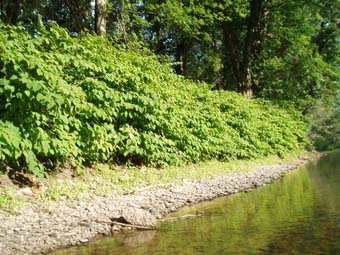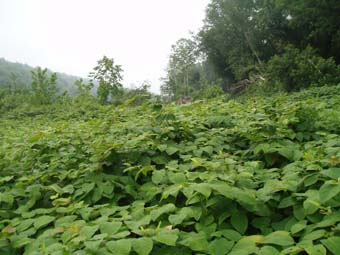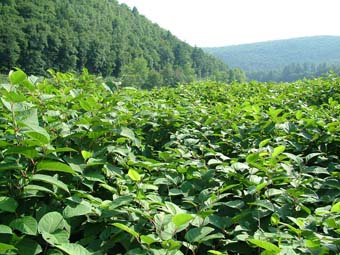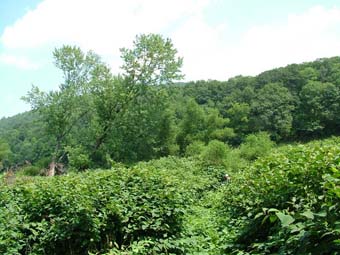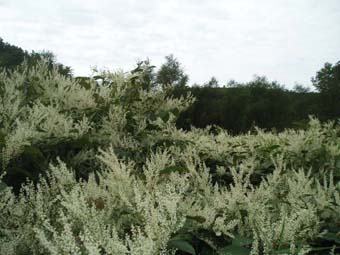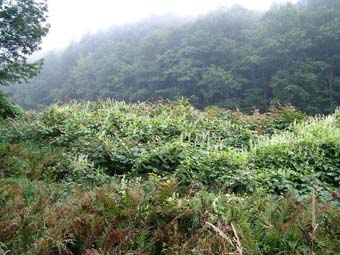Japanese Knotweed Floodplain Thicket
System: Palustrine
Subsystem: Herbaceous
PA Ecological Group(s): River Floodplain
Global Rank:GNA
![]() rank interpretation
rank interpretation
State Rank: S5
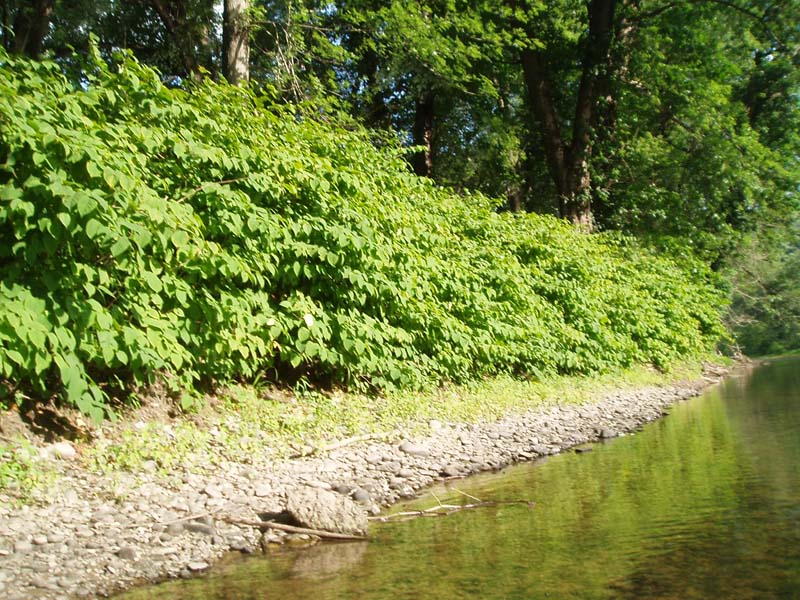
General Description
These are primarily monotypic stands of Japanese knotweed (Fallopia japonica) with few other plant species. Some disturbance-oriented forbs may be present, such as jewelweed (Impatiens spp.), reed canary-grass (Phalaris arundinacea), Virginia cutgrass (Leersia virginica), water-pepper (Persicaria hydropiper), false water-pepper (Persicaria hydropiperoides), lady's-thumb (Persicaria maculosa), and false nettle (Boehmeria cylindrica var. cylindrica), along with seedlings of some woody plants such as sycamore (Platanus occidentalis) and black willow (Salix nigra). The invasive exotic herbs garlic-mustard (Alliaria petiolata) and Japanese stiltgrass (Microstegium vimineum) may be present. This community occurs on islands and along the shoreline of the rivers and streams that are subject to frequent floods and scour. The substrate is typically well-drained, moist, sandy alluvium.
Rank Justification
Common, widespread, and abundant in the jurisdiction. The community type is composed of and dominated by a species that is not native to North America.
Identification
- Near monotypic stands of Japanese knotweed (Fallopia japonica)
- Occurs on islands and along the shoreline of the rivers and streams
- Subject to frequent floods and scour
Herbs
Exotic Species
* limited to sites with higher soil calcium
Vascular plant nomenclature follows Rhoads and Block (2007). Bryophyte nomenclature follows Crum and Anderson (1981).
International Vegetation Classification Associations:
USNVC Crosswalk:None
Representative Community Types:
Polygonum Cuspidatum Temporarily Flooded Herbaceous Vegetation (CEGL008472)
NatureServe Ecological Systems:
Central Appalachian River Floodplain (CES202.608)
NatureServe Group Level:
None
Origin of Concept
Zimmerman, E., and G. Podniesinski. 2008. Classification, Assessment and Protection of Floodplain Wetlands of the Ohio Drainage. Pennsylvania Natural Heritage Program, Western Pennsylvania Conservancy, Pittsburgh, PA. Report to: The United States Environmental Protection Agency and the Pennsylvania Department of Conservation and Natural Resources, Office of Conservation Science. US EPA Wetlands Protection State Development Grant no. CD-973081-01-0.
Pennsylvania Community Code*
na : Not Available
*(DCNR 1999, Stone 2006)
Similar Ecological Communities
Japanese Knotweed Floodplain Thicket is found on similar environmental settings as the Floodplain Meadow, Periodically Exposed Shoreline Community, Reed Canary-grass Floodplain Grassland, and Mixed Forb Marsh but is clearly dominated by an almost monotypic stand of Japanese knotweed (Fallopia japonica).
Fike Crosswalk
None; this type is new to the Pennsylvania Plant Community Classification developed from river floodplain classification studies in the Susquehanna and Ohio River Basins.
Conservation Value
Japanese Knotweed Floodplain Thicket can colonize disturbed flood and scour zones and displace native plant species and communities. While this community is associated with decreasing native species diversity, the community also serves as a buffer for sediment and pollution runoff from adjacent developed lands by slowing the flow of surficial water, causing sediment to settle within this wetland.
Threats
Japanese knotweed is able to colonize disturbed areas and form monotypic clonal stands which decrease both light and nutrient availability to native species. This community can be a threat to and completely displace other wetland communities.
Management
It is important to prevent the spread of this community through invasive species control (herbicide and manual removal) and a natural buffer around the wetland should be maintained in order to minimize the spread of this community into adjacent vegetation.
Research Needs
This community is dominated by an exotic invasive species and there is an increasing need to document the impacts of this community on native plant species and communities.
Trends
The trend of this community is increasing due to the strong competitive nature of Japanese knotweed (Fallopia japonica) within altered environments.
Range Map
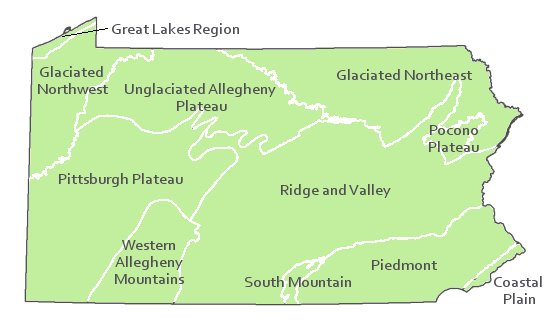
Pennsylvania Range
Throughout Pennsylvania.
Global Distribution
Alabama, Georgia, Kentucky, Maryland, New Jersey, North Carolina, Pennsylvania, South Carolina, Tennessee, and Virginia.
Pennsylvania Department of Conservation and Natural Resources (DCNR). 1999. Inventory Manual of Procedure. For the Fourth State Forest Management Plan. Pennsylvania Bureau of Forestry, Division of Forest Advisory Service. Harrisburg, PA. 51 ppg.
Stone, B., D. Gustafson, and B. Jones. 2006 (revised). Manual of Procedure for State Game Land Cover Typing. Commonwealth of Pennsylvania Game Commission, Bureau of Wildlife Habitat Management, Forest Inventory and Analysis Section, Forestry Division. Harrisburg, PA. 79 ppg.
Cite as:
Zimmerman, E. 2022. Pennsylvania Natural Heritage Program. Japanese Knotweed Floodplain Thicket Factsheet. Available from: https://naturalheritage.state.pa.us/Community.aspx?=30011 Date Accessed: April 23, 2024

